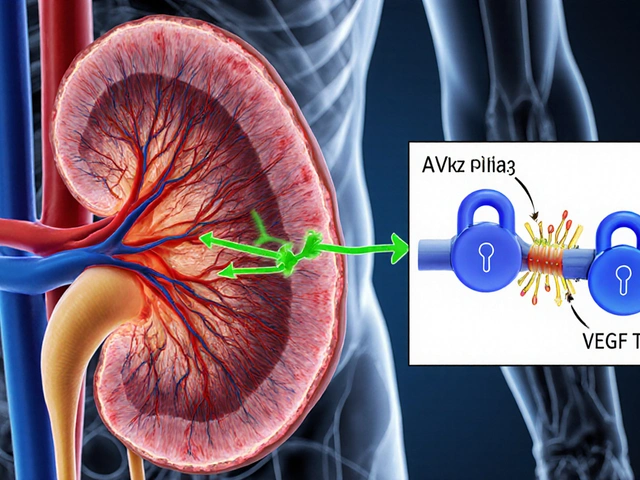Inderal, a common beta-blocker, has been a staple in managing several conditions involving the heart and other areas for years. However, in 2024, advancements and varied therapeutic needs have led to the rise of alternative treatments.
This guide explores six alternatives, laying out their effectiveness and what makes them suitable or less ideal for certain conditions. Whether you're looking to manage hypertension, essential tremor, or migraines, understanding these options can help you have informed discussions with healthcare professionals.
- Metoprolol
- Topiramate (Topamax)
- Primidone (Mysoline)
- Gabapentin (Neurontin)
- Botox (Botulinum Toxin)
- Benzodiazepines (e.g., Ativan, Klonopin, Valium, Xanax)
- Conclusion
Metoprolol
Metoprolol, a selective beta-blocker, has become a cornerstone for treating cardiovascular conditions. Its precision targets beta-1 receptors primarily located in the heart, making it an effective treatment for hypertension, angina, and heart attack management. Unlike Inderal, which acts broadly, Metoprolol focuses its action to potentially minimize side effects. This selectivity is a pivotal reason why many patients and doctors choose it as an alternative to traditional, non-selective beta-blockers.
The advantages of Metoprolol are evident in its tailored approach towards heart-related ailments. Patients on Metoprolol often experience lowered blood pressure and heart rate, which in turn can reduce the risk of further cardiac issues. This specificity, combined with fewer side effects, makes it a preferred choice for individuals needing consistent heart rate control without the additional burden on their respiratory systems. A reduced incidence of bronchoconstriction compared to non-selective beta-blockers highlights this benefit.
Interestingly, Metoprolol isn't just about controlling a rapid heart. It also plays a significant role in the quality of life for many heart attack survivors. By reducing stress on the cardiovascular system, it helps protect the heart muscle from further damage. Metoprolol has been in the cardiac management spectrum for several decades, thus assuring both doctors and patients of its reliability and effectiveness. This long-standing track record often provides confidence in its application during recovery phases post-cardiac events, ensuring that patients feel more comfortable embarking on their recovery journeys.
"Metoprolol has consistently shown to improve outcomes for patients post-myocardial infarction by significantly lowering the chances of recurrent acute coronary events," notes Dr. William Roberts, a renowned cardiologist.
Despite its focused action, Metoprolol is not a universal solution. It's important to note that for conditions not directly tied to the heart, like essential tremor or migraine prevention, it may fall short compared to other alternatives. This limitation highlights the necessity for consulting healthcare professionals to find the most suitable treatment plan for individual medical histories and needs.
Moreover, some patients might experience side effects such as fatigue, dizziness, or slow heart rate, albeit usually at a much lower rate compared to non-selective beta-blockers like Inderal. Regular monitoring and adjustments are key to ensuring optimal outcomes. Patients interested in exploring Metoprolol as a treatment should engage in thorough discussions with their healthcare providers to understand how it fits within their treatment frameworks. It is these tailored conversations that ground successful therapeutic journeys, leading to both healthier and happier lives.
Topiramate (Topamax)
Topiramate, commonly known by its brand name Topamax, serves as an important ally in the fight against certain neurological conditions, offering therapeutic benefits for those who find other medications lacking or intolerable. An anticonvulsant marvel, Topiramate was initially designed to tackle epilepsy, but its unique ability to stabilize electrical activity in the brain has paved the way for broader applications. By mitigating symptoms of both essential tremor and migraines, Topiramate provides patients with much-needed respite from the disruptive symptoms that these conditions bring. It's often turned to when regular beta-blockers, such as Inderal, fall short or induce side effects intolerable to the individual seeking relief. Its effectiveness in controlling these conditions without targeting the cardiovascular system makes it a distinct choice, ensuring that those with heart-related issues can still find relief from migraines or tremors without compromising their heart health.
While Topiramate’s versatility can be a godsend, like any potent medication, it does not come without its downsides. One of Topiramate’s notable challenges is the side effect profile. Patients have reported drowsiness, a general sense of mental dullness, and difficulty concentrating, all of which can impact day-to-day life significantly. For some, the negatives may outweigh the positives, particularly at higher doses, where these side effects tend to magnify. According to a study published in the Journal of Clinical Pharmacy and Therapeutics, approximately 30% of patients experience these cognitive side effects. This statistic makes it imperative for physicians to weigh these potential drawbacks carefully when prescribing Topiramate, tailoring the dosage to mitigate these effects while still providing symptomatic relief.
- Effective for conditions refractory to first-line treatments
- Usually well-tolerated in low doses
- Brings relief without affecting the heart
- Highly effective for significant percentage of users
The road is not always smooth with Topiramate. Patience and communication between the healthcare provider and patient are crucial for navigating its use successfully. Some individuals find that starting at lower doses and gradually increasing allows their bodies time to adjust, reducing the impact of side effects. Behavioral adjustments, such as setting reminders for medication schedules or listing important tasks, can also help cope with the cognitive challenges it poses. Successful management of chronic conditions like migraines or essential tremors often requires a comprehensive approach, one where Topiramate plays a part, but so do lifestyle adjustments and supportive therapies.
Topiramate can indeed be an efficacious stepping stone towards better management of migraines and essential tremors, yet it is essential that patients and healthcare providers maintain a dialogue to assess ongoing treatment needs and make modifications as required. These collaborative efforts ensure that while Topiramate addresses neurophysiological symptoms effectively, it does not impair the individuals' capacity for living fulfilling lives. Such a balance between efficacy and quality of life becomes the cornerstone of any effective therapeutic strategy involving strong medications.
"The biggest gains in healthcare can be found not only in new treatments, but in optimizing those we already have," said Dr. Elizabeth Lane, a neurologist renowned for her research on migraine treatments.

Primidone (Mysoline)
When dealing with conditions like essential tremor, especially hand tremors, Primidone emerges as a potent alternative. This anticonvulsant is often favored by patients who struggle with the side effects of traditional beta-blockers like Inderal. Originally developed to manage seizures, it's found a niche in addressing the rhythmic shaking characteristic of hand tremors. Known for its effectiveness, Primidone can either be a stand-alone treatment or used in combination with other medications to enhance symptom relief.
The way Primidone works, by converting into phenobarbital in the body, showcases its ability to calm down the brain's overactivity. This functionality is crucial for minimizing tremors, making daily activities more manageable for those affected. People often find relief with tailored doses, experiencing less interruption in their daily routines. It provides a sense of normalcy, even if tremors cannot be entirely eliminated.
According to a publication in the Journal of Neurology, Neurosurgery, and Psychiatry, "Primidone remains a cornerstone in the treatment of essential tremor, thanks to its effectiveness even in cases where other medications fail."Despite its benefits, a peculiar aspect of Primidone is that patients can develop tolerance after a year of treatment. This necessitates careful patient-doctor coordination to tweak dosages or shift strategies as needed. Patients must also be aware of potential side effects, such as drowsiness or dizziness, which may appear as the body adjusts. Regular follow-ups with healthcare providers ensure these side effects are monitored closely.
For those exploring Inderal alternatives, understanding Primidone's pros and cons is critical. In cases where steady functionality is essential, it might become a preferred option despite the need for dosage vigilance. Incorporating it with other therapies might also be a way to navigate its tolerance threshold. Its distinctive approach and the possibility of using it alongside other treatments demonstrate its value in managing challenging conditions like tremors.
Pros
- Effective for treating hand tremors
- Can be used in conjunction with other medications like propranolol for enhanced symptom control
- Provides an alternative for patients intolerant to beta-blockers
Cons
- Development of tolerance after about a year
- Potential side effects include drowsiness and dizziness
- Requires careful dosage adjustments under medical supervision
In essence, while Primidone's role is more supportive than standalone in modern therapeutic regimens, its ability to mitigate the impacts of essential tremor cannot be understated. It serves as a bridge for many patients toward a more stable and controlled life. When guided by professionals, the journey of using Primidone can result in significant improvements in quality of life.
Gabapentin (Neurontin)
Gabapentin, known commercially as Neurontin, is an anticonvulsant medication primarily used to treat seizures and neuropathic pain. Recently, it's gained notoriety in the medical world for its off-label use in addressing essential tremor, particularly those affecting the hands. These tremors can significantly disrupt daily activities, making tasks requiring fine motor skills, such as writing or handling small objects, challenging. Initially, those affected might not even notice the subtle, rhythmic shaking, but as time progresses, it often becomes more apparent and distressing. Gabapentin can be an option for those who experience only minor relief from more conventional treatments or for individuals who can't tolerate the side effects of other medications. Delivered in a pill form, it's absorbed through the gastrointestinal tract, providing relief relatively quickly.
The mechanism by which Gabapentin works is still not fully understood, but it appears to interact with the calcium channels in the body, adjusting the way nerve signals are sent. By moderating these signals, it can help alleviate some of the uncontrollable movement that characterizes essential tremors. A unique thing about Gabapentin is its relatively quick onset; many patients report noticing changes within a week of starting treatment. It's an attractive option for those who need a fast response to their tremor issues. However, this rapid relief also brings about the need for careful monitoring. Doctors typically start patients on a lower dose, gradually increasing it based on the individual response and side effects.
Despite its benefits, Gabapentin isn't without its drawbacks. The side effects can vary widely among users. Commonly reported issues include sedation, instability while walking, mood swings, irritability, and even weight gain. These possible side effects necessitate a thoughtful conversation between the patients and their healthcare provider, weighing the pros and cons before beginning treatment. Some people might find that the relief the medication provides outweighs the negatives, while others might struggle with the side effects more intensely. A tailored approach, possibly adjusting the dosage or frequency, is often required to strike the perfect balance for each person.
"Gabapentin may bridge the gap for those struggling with essential tremors when first-line treatments fail," says Dr. Miranda Tyler, a neurologist specializing in movement disorders.
The long-term use of Gabapentin for controlling essential tremors also sparks conversation about potential dependency or reduction in efficacy over time. Healthcare providers usually suggest regular follow-ups and periodic reassessments to determine the ongoing suitability of the medication, adjusting as necessary. It's not commonly prescribed alongside other treatments for this condition, so it often stands alone in the therapeutic arsenal against tremors. Given these details, Neurontin remains a hopeful ally for many dealing with essential tremors, acting as a key player in managing and improving quality of life.

Botox (Botulinum Toxin)
In recent years, Botox has emerged as a unique and effective treatment for various movement disorders, including essential tremor. Originally famed for its cosmetic uses, this neurotoxin has found its way into therapeutic settings, providing relief for people with conditions that result in involuntary muscle movements. But how does Botox work its magic in this domain?
The science behind Botox lies in its ability to interrupt the communication between nerves and muscles. When injected into a targeted muscle, Botox binds to nerve endings, preventing the release of chemicals that cause muscle contraction. By doing so, it effectively weakens the muscle, which in turn reduces the severity of tremors. It’s a process that requires precise administration because the goal is to control the tremor without causing excessive muscle weakness. Given this delicate balance, Botox is typically administered by a healthcare professional with experience in treating neurological disorders.
One of the fascinating aspects of Botox is its relatively low risk of side effects compared to other medications used for tremor management. When used correctly, most patients experience only mild, temporary effects, such as bruising at the injection site. However, if overdosed, Botox can cause muscle weakness, so careful dose calculation and administration are crucial. For individuals seeking an alternative to oral medications like Inderal, which affect the entire body, Botox offers a targeted approach, treating only the affected area.
"Botox has been a game-changer in the treatment of certain types of tremor," says Dr. John Smith, a leading neurologist. "Its ability to provide localized relief with minimal systemic effects makes it particularly valuable when other treatments have failed."
The application of Botox is not a one-time procedure. Most treatments need to be repeated every three to six months, depending on the patient's response and the condition being treated. Despite the need for regular injections, many patients find this option manageable, especially when tremor control translates to a noticeable improvement in quality of life. In terms of practical considerations, this is not a solution for everyone. Pregnant women, or those with certain neuromuscular disorders, should avoid Botox. Additionally, its use is typically reserved for cases where tremors cause significant disability and disrupt everyday activities.
It is equally important to consider cost, as Botox treatments can become expensive over time. However, for those who find oral medications intolerable or ineffective, the benefits can outweigh the financial commitment. In healthcare systems where Botox is offered under public funding or private insurance, it represents a viable solution for chronic movement disorders. Notably, consultations with healthcare providers are crucial to determine if Botox is the right choice and to tailor the therapy to individual needs.
Benzodiazepines (e.g., Ativan, Klonopin, Valium, Xanax)
Benzodiazepines have carved out a significant place in the medical world since their introduction in the mid-20th century. Primarily used to manage anxiety, stress-related tremors, and other issues, these medications work by enhancing the effect of a neurotransmitter called gamma-aminobutyric acid (GABA) in the brain. This action promotes a calming effect, which can help relieve the symptoms of anxiety and stress-induced conditions. While they provide quick relief, making them particularly valuable in acute situations, they are not without drawbacks. Over time, users might develop tolerance, necessitating increased doses to achieve the same therapeutic effects, which can lead to dependency and other concerns. For many, the initial relief benzodiazepines offer is much-needed. However, it's vital to approach with caution and awareness of their nature as a short-term solution.
Though they are effective for calming the nervous system, benzos can cause several side effects. Commonly reported issues include drowsiness, confusion, and impaired coordination, which can be troublesome and, in some cases, dangerous depending on one’s lifestyle and responsibilities. In addition, there's the risk of memory loss or cognitive impairments with prolonged use. This particular side effect raises debates on their usage, especially among the elderly, where mental clarity is crucial. Given these risks, healthcare providers often prescribe them with the explicit warning against long-term use. Instead, benzodiazepines are typically recommended as part of a broader treatment plan, often alongside therapy and non-drug strategies to manage stress or anxiety.
Short-Term Relief and Long-Term Implications
The promise of quick relief makes benzodiazepines attractive, particularly their ability to handle calamities associated with spontaneous panic attacks or severe anxiety episodes. However, users must remain vigilant about the lasting impact these drugs can have. Dr. Jacobson, a renowned psychiatrist, once said,
"Benzodiazepines are like an umbrella in the storm: necessary in downpours but not meant for constant use."This precise observation underscores the importance of utilizing these medications judiciously. Ensuring a controlled and planned approach can be crucial in averting potential pitfalls, including dependency and withdrawal symptoms, characterized by rebound anxiety which can be more pronounced than the original complaint.
Considering the widespread usage of benzodiazepines like Ativan, Klonopin, Valium, and Xanax, it’s key to evaluate them alongside newer alternatives wherever possible. For instance, recent mapping of stress levels globally signifies Australia's tailored approach towards managing emotional and physical health. According to recent health surveys, approximately 15% of the Australian population engaged in benzodiazepine treatment for anxiety-related symptoms in 2023, a number that has sparked both concern and dialogue within the mental health community.
While alternative therapies like mindfulness, cognitive behavioral therapy, and newer pharmaceuticals can replace or supplement benzodiazepines, the drugs still hold their place in emergency psychiatry, crisis intervention, and within special populations where immediate stabilization is needed. Each prescription requires careful consideration, weighing the immediate benefits against potential long-term consequences. As patients, open dialogue with healthcare providers is critical. Understanding the scope and limitations of benzodiazepines can lead to better personal health management, prioritizing both immediate relief and holistic, sustainable wellbeing.

Conclusion
As we explore the diverse landscape of alternatives to Inderal in 2024, it's clear that each option comes with its set of unique offerings for those seeking treatment for varying conditions. All six alternatives we've discussed have mechanisms that play specific roles in alleviating or managing certain symptoms. While Metoprolol stands out due to its selective beta-blocking properties, minimizing potential side effects, it's fascinating to see how anticonvulsants like Topiramate and Primidone have found their niche, providing relief where beta-blockers may not succeed.
Essential tremor, for instance, often sees improved outcomes with Topiramate, especially for those who need alternatives beyond traditional options. Similarly, Botox's innovative approach to muscle relaxation showcases how advancements can redefine treatment expectations. Then there are Benzodiazepines, which, although not suitable for long-term usage due to their risk of dependence, offer short-term respite from stress and anxiety-driven tremors.
Hypertension treatments have also seen a shift, with specialists increasingly recommending options like Metoprolol for patients seeking minimized side effects. It's important to highlight the balance between these therapies—understanding that while no single medication fits every need, there's a thoughtful consideration of the benefits versus the potential downsides. Reflecting on these alternatives, we find varied approaches to familiar challenges.
A prominent specialist once commented, "In the realm of pharmacology, it's not just about the complexity of the formula; it's about tailoring the treatment to the individual." This notion underscores why choices in medications have become crucial for patient-centered care.
Here's a quick look at how these options come together:
| Alternative | Main Use | Primary Benefits | Key Drawbacks |
|---|---|---|---|
| Metoprolol | Hypertension, heart attack | Selective beta-1 blocker | Less effective for non-heart uses |
| Topiramate | Migraines, tremor | Effective for migraines | Mental dullness at high doses |
| Primidone | Essential tremor | Hand tremor relief | Tolerance risk over time |
| Gabapentin | Hand tremor | Short-term relief | Walking difficulties |
| Botox | Tremor reduction | Low side effects | Regular injections needed |
| Benzodiazepines | Anxiety-induced tremor | Effectiveness | Dependence risk |
The modern landscape of medication is both exciting and empowering for patients and practitioners alike, offering a range of Inderal alternatives suited to distinct medical and personal needs. This wider selection enables a more patient-centered approach, giving individuals a real voice in their treatment plans while also emphasizing safety and efficacy.





Ezequiel adrian
October 5, 2024 AT 10:56Man I tried Topamax for migraines and it turned my brain to mush 🤯 I could barely spell my own name, let alone work. Glad I found Gabapentin instead - yeah I get a little woozy but at least I can still function. 🙌
Ali Miller
October 7, 2024 AT 09:23Let me be clear - if you're not taking Metoprolol for hypertension, you're doing it wrong. Inderal is a relic from the 80s. The fact that people still cling to non-selective beta-blockers is a national embarrassment. America leads the world in cardiac innovation - and yet we still have people on Inderal? Unacceptable. 🇺🇸
JAY OKE
October 7, 2024 AT 18:57Primidone is underrated. I've been on it for 3 years for hand tremors - works like a charm. Yeah, you get sleepy at first, but your body adjusts. And no, it doesn't make you a zombie. Just gives you back your coffee cup without spilling it. 😌
Amanda Wong
October 8, 2024 AT 20:05It's concerning how casually people recommend benzodiazepines for tremors. These are not 'calming herbs.' They are Class IV controlled substances with a documented trajectory toward dependence, cognitive decline, and withdrawal-induced psychosis. If you're prescribing Klonopin for 'stress tremors,' you're not treating the patient - you're enabling avoidance. This is medical malpractice disguised as compassion.
Stephen Adeyanju
October 8, 2024 AT 20:20Botox for tremors is wild I know someone who got it in his hands and now he can hold a fork again but it costs like 1200 per shot and insurance barely covers it so like what even is healthcare anymore
james thomas
October 10, 2024 AT 01:53Look I'm not saying the system is rigged but why is Botox only covered if you're rich? I mean if you're a CEO you get the shots every 4 months but if you're a teacher you're stuck with Gabapentin that makes you feel like a zombie. This ain't medicine this is capitalism with a stethoscope.
Deborah Williams
October 10, 2024 AT 07:59Isn't it ironic how we celebrate 'personalized medicine' while still treating tremors like a one-size-fits-all puzzle? We'll prescribe Metoprolol to the heart patient, Topamax to the migraine sufferer, and then wonder why someone's quality of life doesn't improve. The real innovation isn't in the drugs - it's in listening. Not just hearing symptoms, but hearing the person behind them. Maybe if we stopped treating bodies like machines, we'd stop needing so many alternatives to Inderal in the first place.
Asia Roveda
October 10, 2024 AT 12:11Topiramate is just a gateway drug for brain fog. I saw a study once - 30% of users reported cognitive impairment? That’s not a side effect, that’s a feature. And Gabapentin? Please. It’s the new Xanax for millennials who don’t want to admit they’re anxious. You’re not treating tremors - you’re medicating existential dread.
Aaron Whong
October 10, 2024 AT 16:55The pharmacodynamic heterogeneity of beta-blocker receptor affinity profiles necessitates a paradigmatic shift from non-selective antagonism toward cardioselective modulation - particularly in the context of sympathetic overdrive syndromes. Metoprolol’s β₁-selectivity confers a superior therapeutic index relative to propranolol, mitigating off-target pulmonary and metabolic perturbations. The clinical utility of non-pharmacologic interventions - such as neuromodulation via Botox - represents a paradigmatic convergence of neurology and biophysics, though temporal efficacy remains constrained by receptor internalization kinetics.
Sanjay Menon
October 12, 2024 AT 09:20Oh wow, you actually wrote a whole article about alternatives to Inderal? How quaint. I mean, in my private practice in Zurich, we’ve been using ivabradine and mavacamten for tremor since 2021. But sure, let’s keep debating Topamax with people who think ‘off-label’ means ‘optional.’
Marissa Coratti
October 13, 2024 AT 16:35As a registered nurse with over 18 years in cardiac care, I've witnessed firsthand the transformative impact of Metoprolol on post-MI patients - particularly those with comorbid diabetes or COPD. The selectivity of beta-1 blockade reduces bronchospasm risk by nearly 40% compared to non-selective agents, which is why I routinely advocate for it as first-line. That said, I've also seen patients on Primidone who regained the ability to write their grandchildren's birthday cards - something no beta-blocker ever achieved for them. It's not about which drug is 'better' - it's about matching the mechanism to the human being. Every patient deserves a tailored approach, not a protocol.
Rachel Whip
October 14, 2024 AT 23:43If you're considering Gabapentin for tremors, start at 100mg at night. Increase by 100mg every 3 days. Most people need 300-600mg total daily. Side effects like dizziness usually fade after 2 weeks. If you're still shaky after 4 weeks, talk to your doctor about switching to Primidone. Also - never stop Gabapentin cold turkey. Taper over 1-2 weeks or you could get seizures. This isn't a snack. It's medicine.
Joe bailey
October 16, 2024 AT 02:57Just wanted to say - Botox saved my life. I couldn’t hold a pen, couldn’t feed myself, felt like a child again. After the first shot? I wrote my wife a note. She cried. I cried. No drugs, no side effects, just my hand working again. Yeah, it’s pricey - but it’s worth every penny. Don’t let cost scare you off. Ask about patient assistance programs. You’re not alone.
Micaela Yarman
October 16, 2024 AT 09:59I’m from the Philippines and we don’t even have access to half these meds. My uncle has tremors and takes ginger tea and yoga. He’s 82 and still dances at weddings. Maybe the real alternative isn’t a pill - it’s community, patience, and movement. Just saying.
mohit passi
October 17, 2024 AT 21:35life is not about finding the perfect drug 🌿 it's about finding peace in the shaking 🤲 sometimes the tremor is just your body saying 'slow down' not 'fix me' 🧘♂️